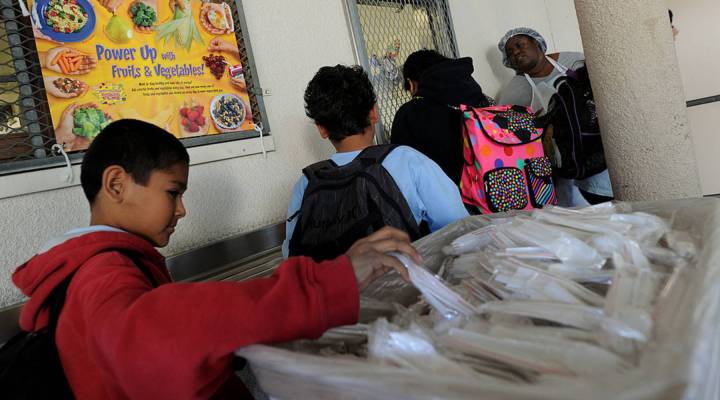
How LAUSD raised the bar for chicken lunches

Besides tater tots, few things seem more like a stereotypical school lunch than chicken nuggets. Yet, for two years, the Los Angeles Unified School District (the second-largest school district in the country) has been chicken-less after negotiations fell through with Tyson and Pilgrim’s Pride, two of the country’s largest chicken distributors. The cause behind the falling out? Not the quality of the chicken, but the chicken’s quality of life.
This month, L.A. Unified is expected to bring chicken back. And this time, its sourcing better meets the labor and production standards that tanked negotiations back in 2015. Howard Blume, who covers education for the L.A. Times, spoke with Marketplace host Kai Ryssdal about the chicken of L.A. Unified. An edited transcript of their conversation follows.
Kai Ryssdal: How did we get to the point where there is a chicken comeback happening in the cafeterias of the Los Angeles Unified School District?
Howard Blume: Well, before the comeback there was the shortage, and the shortage had to do with L.A. Unified trying to enforce higher standards on, not only the chickens, but the way the chicken workers were treated, the way the environment was treated by the chicken plants. The marketplace is changing for chicken. If you go on to a chicken suppliers website, you will now see them boasting about chickens that have never been fed antibiotics, that have oregano-tinted water, etc., as an anti-oxidant. But still, the life of a chicken is not that great when you get right down to it. And L.A. Unified was interested in the nutritional quality of its chicken and the whole chicken supply chain. And what they found out was that no one could meet their standards.
Ryssdal: Is there a chance that because it is so big, the LAUSD could sort of lead the way? Not just elsewhere in California, but across the country in school districts deciding that this is what they’re going to do with this menu item for their kids that’s going to cost more, but has social value too?
Blume: I think L.A. Unified has led the way, and we beat up on L.A. Unified a lot here in Los Angeles and at the Los Angeles Times. But if we’re looking for something, say, to give them credit for, they have led the way on this issue even though, as with many activist policies pursued by the school district, it does cost more money.
Ryssdal: We should point out here that the entire issue of school lunches, chicken or not, is amazingly complicated. Not only is there the cost, but there are federal nutrition standards, there’s the preparation on-site issues, there’s the supply chain. I mean, there’s all kinds of things that districts have to think about when they consider what goes on the kid’s plate when they stand in that food lunch line.
Blume: That’s right. And L.A. Unified has not just been focused on chicken. They also have a program to purchase locally produced fruits and vegetables, for example, and that has been a big boon to the local providers of that. They outlawed junk food in their vending machines. They now serve breakfast in the classroom. They have this expanded food program, and thus can hire more workers. So there’s nothing simple in education. I also should point out that L.A. Unified has hired a chef at some point, but, you know, after you produce this food in a central kitchen and wrap it up and reheat it, even if it started off delicious, it may not be as good and delicious as in the eye of the beholder. What a lot of kids are used to eating is more delicious than nutritious, shall we say.
There’s a lot happening in the world. Through it all, Marketplace is here for you.
You rely on Marketplace to break down the world’s events and tell you how it affects you in a fact-based, approachable way. We rely on your financial support to keep making that possible.
Your donation today powers the independent journalism that you rely on. For just $5/month, you can help sustain Marketplace so we can keep reporting on the things that matter to you.


















